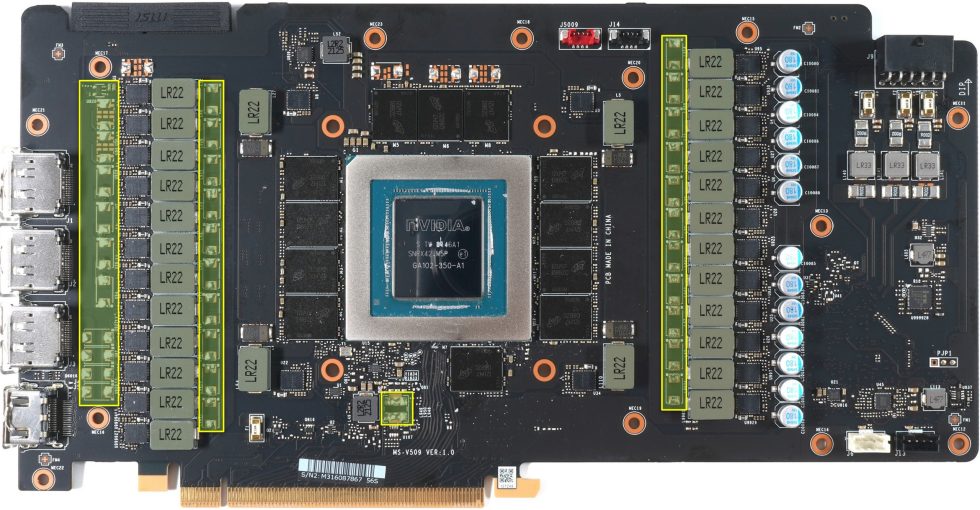The GeForce RTX 3090 Ti PCBs are NOT compatible with the AD102 “Ada”, I would like to preface this here. But how can one come to this hasty conclusion? After I wrote a news about the pin compatibility between the GA102 and the AD102, there was speculation if we are already seeing the next generation design on the GeForce RTX 3090 Ti boards. As beautiful as the whole thing may be, it is unfortunately not quite true. These speculations were triggered (besides my news at the time) by the boards of some GeForce RTX 3090 Ti, which were concluded to have even higher wattages due to free soldering spots in the area of the voltage converters. That is tempting and seems plausible, but it is a bit off the mark.
Let’s take a look at the board of the MSI GeForce RTX 3090 Ti SUPRIM X I tested. Compared to some other GeForce RTX 3090 Ti (like the Zotac RTX 3090 Ti AMP Extreme Holo), MSI has equipped all voltage converters here, i.e. 24 for the GPU (NVVDD) and 4 for the memory (FBVDDQ). The fact that individual voltage transformers are sometimes omitted from the finished product is completely normal and also serves to save costs. Or you know from the start that you don’t need all of them and use the possible variants in advance of development to optimize the hotspots on the cooler.
On the board shown here we can see that e.g. in the area of the voltage converters a lot of polymer capacitors are missing, which can be used to stabilize the output voltage in the voltage converter at higher power consumption values. I don’t want to explain the principle of the switching power supply here again, but the capacitors are arranged e.g. after the coils, lead against ground and act like a small accumulator, which buffers and smoothes the energy stored in the coils and released later. However, what we interpret here as a missing part is still completely equipped on the reverse. The manufacturer thus omits about the maximum possible capacity by parallel connection, because these components exist only up to a certain size. There is also one of the low voltages missing in the 1.8 and 1.2 volt generation range, but that is another topic.
Now, one could speculate that this has already been pre-built for the AD102 and the up to 600 watts, but this is also incorrect. I already wrote that there is a 600W BIOS for the GA102, with which you can also use the board of the GeForce RTX 3090 Ti (and later Ada) as a so-called “test vehicle”, i.e. as a pure test object to gather experience. Nevertheless, the AD102 will not run here. MSI has also experimented with PCIe 5.0 and the 12+4 connector of the power supply on the board, for example, which is proven by the remains of the non-soldered jumper that could be used to switch between 450 and 600 watts.

NVIDIA has very restrictively instructed the board partners to irreversibly limit the power consumption of the GeForce RTX 3090 Ti to 450 watts (“hard wired”) and in the end, any violation of this specification would also be a real breach of contract. MSI didn’t solder the jumper on the final card, and an attempt on my part to simply override that once with a ground jumper showed no effect on power consumption. Logically. In addition, the boards of the GeForce RTX 3090 Ti do not yet comply with the final specification of the new PCIe 5.0 standard.

Of course, there are already areas on the board that correspond almost 1:1 to those of the new designs. This includes, for example, the area of memory and its power supply. The 24 voltage converters for the GPU and he controller are also set, just like the omission of the second PWM controller for the no longer existing MSVDD. In contrast, some more control circuits for extra-low voltages are added and also various circuits that the GA102 does not need. Even though fragments of the new design can already be seen on these boards, the AD102 will not run on them. It is and remains a pure GA102 playground.
Incidentally, this is also due to the fact that the boards of the GeForce RTX 3090 Ti were already finished last year, but the board partners only received the complete new board designs for the upcoming generation in February 2022. Therefore, important details are still missing on the current boards. Yes, the GA102 will also run in the new evaluation boards for Ada (limited), but unfortunately it is not backward compatible.
|
|
|
































Bisher keine Kommentare
Kommentar
Lade neue Kommentare
Artikel-Butler
Alle Kommentare lesen unter igor´sLAB Community →